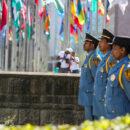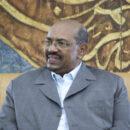The Future of Sudan: One State or Several? – By Seifulaziz Milas

Sudan’s President, General Ahmed Al-Bashir and South Sudan’s President Silva Kiir met in Addis Ababa on 4th January for talks aimed at resolving their on-going conflict. But this has all happened before, and is likely to happen again, until they come to address the underlying causes of the conflict. Sudan is a country of extreme ethno-cultural diversity with some 80 or more ethnic groups, mostly, territorially-based, whose interests have long been subordinated to those of Khartoum-based elites.
Sudan’s internal wars appear to be increasing rather than decreasing. The new wars in the Southern Kordofan and Blue Nile regions are expanding, while the long-standing Darfur conflict continues unabated. A key question is how long can Khartoum manage to continue fighting in three regions ranging from its western to eastern borders? This has consumed crucial resources at a time where these are rapidly diminished since Khartoum lost control of South Sudan’s oil production.
Sudan’s 2005 Comprehensive Peace Agreement (CPA), mediated by the Inter-Governmental Authority on Development (IGAD), sought to address the problems of Sudan’s diversity through the decentralization of powers. However, its Interim National Constitution was more federal in form than in practice and the “˜CPA was not “˜comprehensive’ enough. It was essentially an agreement between the two main belligerent parties and largely addressed the interests of Khartoum’s ruling National Congress Party (NCP), and the South’s dominant Southern Peoples Liberation Movement/Army(SPLM/A).
The CPA gave little attention to Sudan’s other groups, including the SPLM’s allies in South Kordofan, and Blue Nile, and rebel movements in Darfur and among the Beja of the Northeast. It offered Khartoum what appeared to be an opportunity to continue its traditional strategies of “˜divide and rule,’ but the result has been continued conflict. What was known as the “˜Southern Problem’ was, and remains, the problem of Khartoum – of a state that has yet to learn to accept the inhabitants of its peripheral regions as citizens equal to those of Khartoum, and the “Arab” populations to its north along the Nile.
The “Southern Problem” has gone its way and become the new Republic of South Sudan, but has not been resolved. Calling it the “Southern Problem” may have only served to divert attention from the true nature of what was, and remains, the bigger “Sudanese Problem.”
The CPA, while it provided the South with the possibility of a referendum on independence, also offered Khartoum an opportunity to avoid the secession of the South by providing for a six year interim period during which it would have the chance to “˜make unity attractive.’ But “˜making unity attractive,’ was never likely to happen. It would have required breaking the hold of the traditional northern elites on Sudan’s central government, and the powers that have enabled them to control the country’s economy and exploit its resources to the detriment of the populations of its peripheral areas.
It would also have required General Ahmed Al-Bashir’s Islamist NCP Government to give up its ideology of forcible Arabization and Islamization of the Sudanese peoples, its justification for its seizure of their resources for the benefit of the Khartoum-based elites. This, they found difficult to accept.
Sudan’s decades of conflict continue with no end in sight. The recent arrest of key security officials is indicative of what may have been a failed coup attempt. It is indicative, as well of the difficulties of organizing a successful one. President Al-Bashir is well aware of such dangers to his regime and has taken measures to divide his security forces to make a coup more difficult, including concentrating power in a small circle of trusted officials.
Overall, Al-Bashir’s regime is in deep trouble and facing multiple problems that could threaten its existence. In particular it faces an economic crisis that even agreement with South Sudan to resume the flow of oil is unlikely to resolve, and an increasingly hard-pressed urban public. He talks of addressing the economic crisis by increasing gold exports to seemingly most unlikely levels, but most of Sudan’s gold production is in the hands of small artisanal miners and never passes through government hands. The miners prefer to sell their gold to black market operators who have their own means of exporting it and pay a better price.
Meanwhile, the Sudanese economy is in freefall. The wars in South Kordofan, Blue Nile State, and Darfur, led by the Sudan Revolutionary Front (SRF) are draining the treasury and weakening the military. The urban population, in particular, is feeling the economic pressure and as fuel and food subsidies are affected. As life becomes increasingly difficult for the urban poor and middle classes, opposition to Al-Bashir’s NCP regime is on the rise, and with it, some say, the possibility of the sort of popular uprising that has in the past unseated similar regimes in Khartoum. But Sudan has changed since those days and Al-Bashir is more ruthless than its previous post-independence rulers.
As usual when confronted by opposition, the Khartoum regime has opted for a military solution, but its capacity to impose one appears to be diminishing. The current strategy appears to be based on ethnic cleansing in the conflict areas. Based on the guerrilla concept that the population is the sea in which the guerrillas swim, like fish, Khartoum’s strategy, is to drain the sea. That is, to displace or eliminate the populations among which the guerillas operate. This was the strategy employed in the Nuba Mountains of South Kordofan and Blue Nile during the 1990s, when up to 300,000 people were killed and hundreds of thousands more were displaced.
Nevertheless, in the 1990s, this strategy had limited success and the same is likely to be true today. In the meantime, Khartoum’s problems are coming closer to home. The costs of conflict to what has become a non-oil economy are taking their toll. This is reflected in the current rapid decline in the value of Sudan’s currency, an upward surge in inflation, particularly in the costs of food and fuel, which the Khartoum government can no longer afford to subsidize.
The fighting in South Kordofan’s Nuba Mountains erupted in June 2011 when Sudanese army forces moved into the region in an attempt to disarm Nuba militias of the SPLM-North. The local veterans of the North-South conflict who fought on the Southern side, could number 20,000 or more. Their numbers are fewer than those of the Sudan Armed Forces (SAF) but enough to make life difficult for the SAF. And they have the advantage that the terrain in the Nuba Mountains and Blue Nile has proven conducive for guerrilla operations.
Normally it would have seemed that the Khartoum regime had enough on its plate with the wars in South Kordofan and Darfur. But notwithstanding that, al-Bashir chose to launch yet another war in Blue Nile state, bordering Ethiopia, leading to the displacement of tens of thousands of civilians and the flight of thousands of refugees across its borders into Ethiopia and South Sudan. Blue Nile is also home to thousands of veterans of the North-South civil war. Khartoum appears to have picked an inopportune time to launch a new war, with the country facing an economic crisis marked by weakening currency, rapid inflation, and, growing urban discontent.
Sudan’s rapidly weakening currency and accelerating inflation, has led to a crisis of high, and for ordinary urban Sudanese, unaffordable food prices, forcing painful household spending cuts, even on locally produced items. There appears to be no end in sight. With the focus on oil over the past two decades, agricultural development has deteriorated. And the greater part of Sudan’s most fertile lands lie in South Kordofan and Blue Nile, which are now conflict zones.
It appears increasingly likely that the continuation of Khartoum’s current policies could lead to the further fragmentation of Sudan. Nevertheless, there are so far no visible indications of willingness on the part of Khartoum to consider any significant change in its current policies and strategies. A key reality of Sudan is that from its independence in 1956 to present, it has been almost continuously affected by civil war between the center and one or other region of its periphery. Since 1972 a series of agreements were made to improve relations between Khartoum and its peripheral territories. But all were violated, when convenient, by Khartoum.
What remains of Sudan after the South’s independence is still a multi-ethnic, multi-religious society, very similar to its predecessor. It faces similar issues of racial, ethnic, regional, and religious hegemony; coercive Arabization; and ethnic elite control of land and other resources. It needs to resolve these issues in ways acceptable to the populations of its peripheral regions, and recognize all Sudanese as equal members of Sudanese society. Failure to achieve this is likely to lead to further conflict and further fragmentation of Sudan. A viable alternative could be a genuinely federal structure with sharing of power and resources among the federal units (states), and the central government, based on recognition of the need for laws, policies and a coherent vision that addresses the issues of inclusion and management of diversity.
For Sudan, time could be running out. Nearly all of its revenue, and over 90 percent of its foreign exchange, came from its exports of South Sudanese oil. But this is largely lost. Sudan’s wars are costly and Khartoum’s finances are rapidly decreasing. With international debts of some USD40bn, and little possibility of repayment, it is finding it increasingly difficult to find further loans, without which financing its current wars could also be difficult.
A genuine federal system might provide an effective means of enabling Sudan’s diverse communities to live together. It would require considerable effort and attitudinal change on all sides, but would also have benefits for all concerned. After all, if it fails to settle its current wars, in South Kordofan, Blue Nile and Darfur, Sudan could find itself both a much smaller country, and a bankrupt one.
Seifulaziz Milas is author of Sharing the Nile: Egypt, Ethiopia and the Geo-Politics of Water.







[…] Milas  is author of Sharing the Nile: Egypt, Ethiopia and the Geo-Politics of Water. aa Share this:StumbleUponTumblrPinterestDiggLinkedInGoogle +1MoreTwitterFacebookLike this:LikeBe the […]
“It appears increasingly likely that the continuation of Khartoum’s current policies could lead to the further fragmentation of Sudan.”
These days everyone is a Sudan expert.